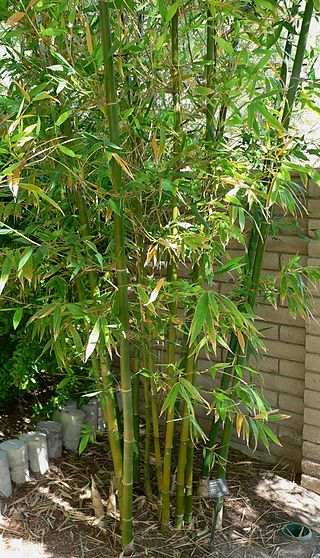
Bambusa is a large genus of clumping bamboos. Most species of Bambusa are rather large, with numerous branches emerging from the nodes, and one or two much larger than the rest. The branches can be as long as 11 m (35 ft).

Dendrocalamus is a tropical Asian genus of giant clumping bamboos in the grass family. It is found in the Indian subcontinent, China, and Southeast Asia.

The Bambuseae are the most diverse tribe of bamboos in the grass family (Poaceae). They consist of woody species from tropical regions, including some giant bamboos. Their sister group are the small herbaceous bamboos from the tropics in tribe Olyreae, while the temperate woody bamboos (Arundinarieae) are more distantly related. The Bambuseae fall into two clades, corresponding to species from the Neotropics and from the Paleotropics.

The Melocanninae is a subtribe of bamboo.
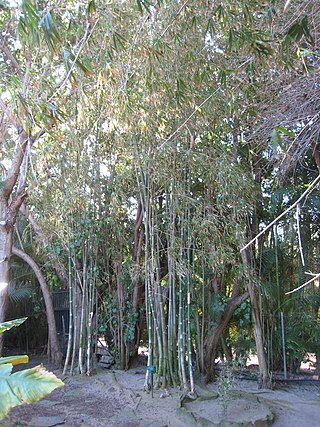
Gigantochloa is a tropical Asian and Papuasian genus of giant clumping bamboos in the grass family. It is found in southern China, Southeast Asia, the Indian subcontinent, and New Guinea.

Cephalostachyum is a genus of Asian and Madagascan bamboo in the grass family.
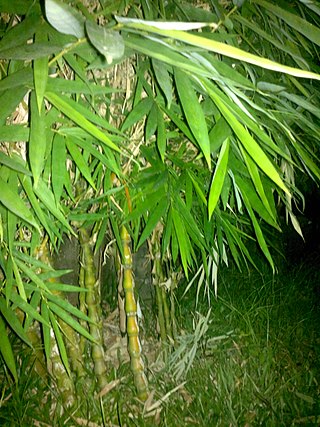
Ochlandra is a genus of Indian bamboo in the grass family).

Schizostachyum is a tall or shrub-like tropical genus of bamboo. They are natives mostly of tropical Asia and Papuasia, with a few species in Madagascar and on certain islands in the Pacific. A few have become naturalized in other tropical regions.
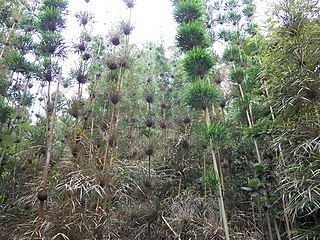
Nastus is a genus of slender, erect, scrambling or climbing bamboos in the grass family. It is native to Southeast Asia, Papuasia, and certain islands in the Indian Ocean.

Mautâm is a cyclic ecological phenomenon that occurs every 48–50 years in the northeastern Indian states of Tripura, Mizoram and Manipur, as well as in many places of Assam which are 30% covered by wild bamboo forests, and Chin State in Myanmar, particularly Hakha, Thantlang, Falam, Paletwa and Matupi Townships. It begins with a rat population boom, which in turn creates a widespread famine in those areas.
Giant bamboo is a common name for several large species of bamboo and may refer to:
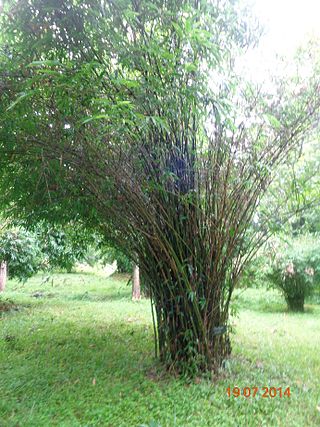
Bambusa tulda, or Indian timber bamboo, is considered to be one of the most useful of bamboo species. It is native to the Indian subcontinent, Indochina, Tibet, and Yunnan, and naturalized in Iraq, Puerto Rico, and parts of South America.

Bambusa lako, known as Timor black bamboo, is a large species of bamboo originating from the island of Timor; its black culms may reach 21 m (69 ft) in height. A 2000 molecular study places it as closely related to the similar Indonesian species Gigantochloa atroviolacea, from which it was separated in 1997; it may soon be placed in that genus. Bambusa lako can only be grown in climates that are mostly frost free.

Bamboo shoots or bamboo sprouts are the edible shoots of many bamboo species including Bambusa vulgaris and Phyllostachys edulis. They are used as vegetables in numerous Asian dishes and broths. They are sold in various processed shapes and are available in fresh, dried, and canned versions.
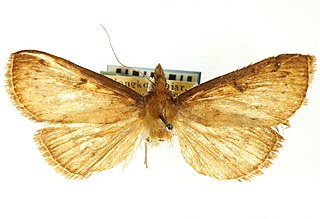
Omphisa fuscidentalis, the bamboo worm, is a moth of the family Crambidae. Its habitat are the bamboo groves and forests in the cooler regions of northern Thailand, northern Laos, northern Myanmar, and adjacent parts of Yunnan Province, China, it is also found in some parts of North east India. The mature caterpillars are viewed as a delicacy by the inhabitants of these regions.

Matapa is a genus of grass skipper butterflies in the family Hesperiidae. The species of this genus occur in the Indomalayan realm, from India to Sulawesi. They are mainly crepuscular and have red eyes.
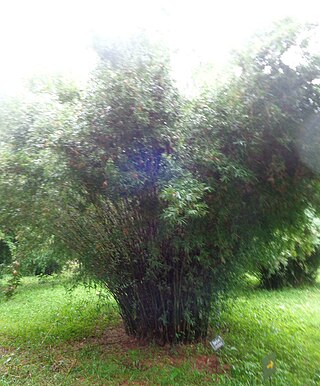
Bambusa multiplex is a species of bamboo native to China, Nepal, Bhutan, Assam, Sri Lanka, Taiwan, and northern Indochina. It is also naturalized in Japan, Iraq, Madagascar, Mauritius, Seychelles, the Indian subcontinent, parts of South America, the West Indies, and the southeastern United States.
Purwodadi Botanical Garden is a research centre in Purwodadi, Pasuruan, East Java, Indonesia. It has an area of 85 hectares and more than 10,000 types of trees and many plant collections. Callus cultures of Agave amaniensis by Setia Dewi were taken in 1988.
The Jatna’s tarsier, also known locally as the mimito, is a species of tarsier endemic to the northern Sulawesi, Indonesia. Previously classified together with the Spectral tarsier, this species was reclassified and elevated as a separate species in 2017 due to their distinct and separate acoustic duet calls between males and females.
Pseudobambusa schizostachyoides is a species of bamboo in the monotypic genus Pseudobambusa, of the tribe Bambuseae. No subspecies are listed in the Catalogue of Life.














